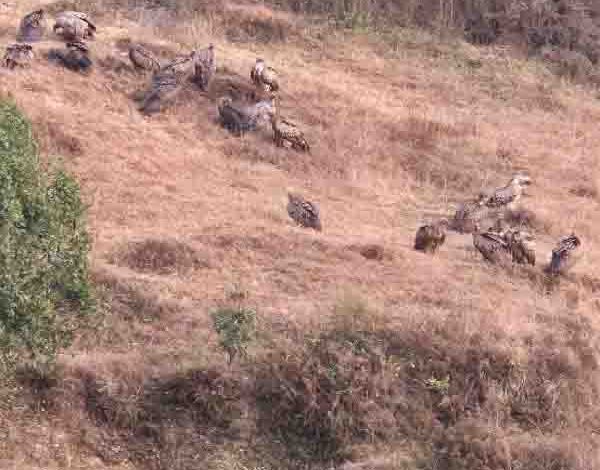GUEST COLUMN : Sighting of Himalayan griffon vulture a positive sign

 GS Rajwar
GS Rajwar
During my visit to the Himalaya in Garhwal during the last week of December 2024, I encountered about a dozen vultures feeding on a mule carcass on Moryana Top hill in Tehri district. Since this species has been categorised as a Near-Threatened (NT) species of vulture in India in the Red List of the International Union for the Conservation of Nature (IUCN), its sight and that too in a group is a good sign. A researcher identified its picture as the Himalayan Griffon vulture (Gyps himalayensis). The population of this vulture species is also decreasing. The other species of vultures recorded in India include the Indian vulture (Gyps indicus) or long-billed vulture, slender-billed vulture (Gyps tenuirostris) or Himalayan long-billed vulture, Egyptian vulture (Neophron percnopterus) or the white scavenger vulture, red-headed vulture (Sarcogyps calvus) or the Asian king vulture, the white-rumped vulture (Gyps bengalensis), also known as Indian white-backed vulture, griffon vulture (Gyps fulvus), also known as Eurasian griffon, the cinereous vulture (Aegypius monachus) or the black vulture and the bearded vulture (Gypaetus barbatus), also known as lammergeier. The population of Indian vulture, slender-billed vulture, red-headed vulture and white-rumped vulture is categorised as critically endangered in the IUCN Red List, Egyptian vulture as endangered while cinereous vulture and bearded vulture are categorised as near threatened along with the Himalayan griffon. Only one species, the griffon vulture has been placed in the least concern category of the IUCN Red List with its population increasing.
Vultures are also known as keystone species in the ecosystem. Himalayan griffons are found in rocky areas and mountain peaks in the Indian Himalayan region. These vultures, mostly reside in altitudes between 1,200 and 5,500 metres. These large vultures have pale plumage compared to the griffon vulture and distinct stout bills. They possess white heads, which is one of the identification features. Himalayan griffons are usually not seen near villages or human settlements. They mainly feed on the carcasses of large mammals and monitor other scavenging birds to locate the dead animals or carcasses. They live in small colonies or groups, often dominating feeding areas and preventing other vultures from sharing the carcass. Himalayan griffons build nests within caves and are known to return to the same nesting site. The Himalayan griffon is the second-largest Old World vulture species, native to the Himalaya, foothills in north and north eastern India and the Tibetan plateau which can live up to 40-45 years of age, plays a role in controlling the spread of harmful pathogens that cause diseases like anthrax, cholera, foot and mouth disease, rabies and distemper, and it also prevents the contamination of water sources.
The vultures almost vanished in India and neighbouring countries for a long time, and due to restrictions on some drugs and conservation efforts these species are not being recorded in some parts of India. The vultures were earlier an abundant and ubiquitous bird in India and they hovered over sprawling landfills, looking for cattle carcasses. Sometimes they also were involved in bird hits with aircrafts during take offs. These scavengers are considered nature’s sanitation service because of their important role in removing dead animals that contain bacteria and pathogens from our environment and without them, there may arise disease spread and an epidemic. The near-extinction of the birds across India in the 1990s led to the spread of disease-carrying pathogens from an excess of dead animals, killing more than a half million people from 2000 to 2005. According to a BBC report, the decline of Indian vultures led to 5,00,000 human deaths. The story of vulture decline started in 1994 when farmers began giving the drug diclofenac to cattle and other livestock for pain, inflammation and other conditions. But it was poisonous to the vultures that fed on these animals, destroying their kidneys. The main cause of their decline was the rampant use of diclofenac, a cheap non-steroidal painkiller for cattle that is fatal to vultures. During the monitoring of the vulture population of Keoladeo National Park in 1990s, Vibhu Prakash of the Bombay Natural History Society observed a decrease in the number of vultures. The declining population of vultures was also noticed by the villagers in northern India in mid 1990s. But more than three decades ago, India’s vultures began dying because of this drug used to treat sick cows. The decline in the vulture population happened not only in India, but also in neighbouring countries Pakistan, Nepal and Bangladesh. By the mid-1990s, the 50 million-strong vulture population declined to near zero because of diclofenac. As per the State of India’s Birds Report, the ban on the veterinary use of diclofenac in India since 2006, the decline has slowed in some areas, but few species have suffered long-term losses of 91-98 per cent.
A study published in the American Economic Association journal shows that the unintentional decimation of these heavy, scavenging birds allowed deadly bacteria and infections to proliferate, leading to the deaths of a large number of people. The vultures play an important role in securing human health and protecting wildlife. A study estimated that between 2000 and 2005, the loss of vultures caused around 1,00,000 additional human deaths annually, resulting in more than $69 billion per year in mortality damages or the economic costs associated with premature deaths. These deaths were due to the spread of disease and bacteria that vultures would have otherwise removed from the environment. The stray dog population also increased, bringing rabies to humans. Unlike vultures, dogs were ineffective at cleaning rotting remains, leading to bacteria and pathogens spreading into drinking water through runoff and poor disposal methods. Some other threats to vultures are the use of pesticides and herbicides, other toxins, lead poisoning, vehicle collisions, electrocution and starvation.
Vultures in India live in communities. In India, the white-rumped vulture, Indian vulture and red-headed vulture have suffered the most significant long-term declines since the early 2000s, with populations dropping by 98 per cent, 95 per cent and 91 per cent, respectively. The Egyptian vulture and the migratory griffon vulture have also declined significantly, but less catastrophically. The 2019 livestock census in India recorded more than 500 million animals, the highest in the world. Vultures, highly efficient scavengers, were historically relied upon by farmers for quickly removing livestock carcasses. The sensitivity to diclofenac differed in various species of vultures. The white-rumped vulture is more sensitive to diclofenac. The Himalayan griffon and the Eurasian griffon were less affected because they were found in smaller initial populations and were exclusively mountain-dwelling populations. The people of the Parsi community in India leave the dead bodies exposed in high towers called Towers of Silence for the vultures to feed. Due to the decline in the vulture population, they have been forced to drop the ancient customs for hygiene reasons.
According to the State of India’s Birds report, India’s remaining vulture populations are now concentrated around protected areas where their diet consists more of dead wildlife than potentially contaminated livestock. Some other drugs developed as alternatives to diclofenac such as acetofenac, ketoprofen and nimesulide have also been reported to be toxic to vultures. Diclofenac for human use was still being diverted into veterinary uses through the illegal sale of multidose vials intended for humans for use in cattle in 2011. The ban was strengthened by the ban on vials larger than a single human dose (3 ml) in 2015, but vials were still manufactured illegally. While the ban on diclofenac has been successful in Nepal and Bangladesh, it was widely available in India. The drug is still in use in some European countries such as Spain, which is a native of 90 per cent of European vulture population.
Several conservation efforts are now in place to protect and increase the vulture populations in the country. Captive breeding programmes for the Indian vulture were started to help recover its numbers, though this method is slow and difficult because vultures are long-lived. Important vulture conservation programmes include the establishment of the Vulture Conservation Breeding Centre (VCBC) in Pinjore, Haryana by the Bombay Natural History Society (BNHS) and the Haryana Forest Department, efforts by the organisation ‘Saving Asia’s Vultures from Extinction’, and the programmes in Karnataka, Tamil Nadu, West Bengal, Assam and Madhya Pradesh. The Ministry of Environment, Forest and Climate Change has started an Action Plan for Vulture Conservation 2020-2025 for vulture breeding programmes. The population of vultures is recovering slowly in India with a strict ban on the drugs causing harm to the vultures. There are some examples of sights of vulture populations in some parts of India. There is certainly hope for the comeback of vultures in India and neighbouring countries.
(The author is professor emeritus of Sparsh Himalaya University, Dehradun and a fellow, Linnean Society of London. Views expressed are personal)






